“Beppu, with a population of 62,300, is known throughout Japan for its hot springs, which include alkaline, sulphur, iron and carbonated baths, efficacious for various ailments.
“Among the numerous public baths, some owned privately and some by the municipality, the Hurosen is general the most popular among foreign visitors. There are also hot sand baths on the beach, a special feature of the spa, where people half bury themselves in the sand.”
– Japan: The Official Guide, Japan Government Railways, 1941
See also:
Onsen culture
S.S. Murasaki Maru, Beppu, 1929
“The compact town (pop. 10,000) [of Beppu] stands on the sea-edge of a small scorified plain which reaches back to, and up the sides of, three extinct volcanoes — Yufu, or Tsukushi Fuji (often called the Bungo Fuji), 4850 ft. high, and said to be the loftiest peak in Bungo; Tsurumi (3619 ft.), a bare mt. at the right of it; and Takasaki (2067 ft.), at the S. end of the town, often called Shikioku-san, and remembered by the natives for the splendid castle (destroyed during the war for the Restoration) which occupied a terrace on its side high above the sea.
“The last outburst from Tsurumi was in the 17th century, when it filled the valley with the clinker-like scoria of numerous lava streams. In due course much of this cindery stuff decomposed and gave rise to the rank vegetation which now clothes the skirts of the mountain in perennial green. But in places the old volcanic wounds failed to heal, and they now advertise their presence by suppurating sores, in the form of furiously boiling chemical pools flush with the surface, or mineral springs that spurt out steam and water blistering to the touch.
“The [Beppu] district seems all underlaid with infernal fires, some of which are so close to the surface that the people cook their daily food over holes punched in the earth. In places the crust is so thin that to sink in means to have a foot parboiled or burned to a cinder, while at others there are agitated ulcers which spit out scarifying blobs of liquid mud accompanied by menacing sounds and noisome stench. Streams of steam ing water showing all the colors of the rainbow rush down from the hills through the gutters of the town, and impart a most infernal look to the place.”
– Terry’s Japanese Empire, by T. Philip Terry, 1914
“[With regard to former Prime Minister Matsukata Masayoshi, when he was governor of Hita Prefecture (1868-1871):] One of the more interesting of his many projects was the construction of a harbor in Beppu … On visiting the town of Beppu for the first time, Matsukata was forced to wade ashore through heavy surf because there was no harbor or dock. He spoke to the men of the town about his undignified manner of arrival and pointed out that they could make Beppu, with its many fine hot springs, a prosperous resort to attract people from all over Japan. They received his suggestion with enthusiasm and immediately started raising money for their harbor. Finding their funds still insufficient, they came back to ask for a loan of 15,000 ryo ($37,000). Matsukata did not have the cash available but provided them with loan of 20,000 ryo in national certificates, and the port was built.
“A stone memorial inscribed with Matsukata’s calligraphy still stands at the entrance of the harbor, and Beppu today is the most famous hot-spring resort in Japan.”
– Samurai and Silk: A Japanese and American Heritage, Haru Matsukata Reischauer, 1986
“Beppu’s history begins with a legend where two gods visited ‘the ancient country’; when one got sick, the other pulled up a long pipe from the seabed of Beppu Bay, opening up the ‘springs’ from the underground to bathe and cure the sick one. Beppu’s healing power is referenced throughout Japanese history. During the Kamakura period (1192-1333 CE), sanatoria were built in the city to treat soldiers wounded during the Mongol invasion (an event immortalized as the Kamikaze).
“Modernization and the importing of Western technology after the Restoration in 1868 resulted in the drilling of more than 1000 new holes to generate thermal waters.
- Sand bathers and excursion steamer, Beppu, c. 1930.
- Natural springs “hot bath”, Beppu, c. 1930.
“[O]ne may witness the somewhat curious and unusual (to Occidentals) spectacle of scores of men and women, old and young, plump and wrinkled, charming and otherwise, bathing promiscuously, but overstepping in no wise the modesty of nature. There are many such baths in Japan; at Beppu one may see almost any number of innocent nude bathers stretched on the beach, with piles of healing sand scattered over them; while in the adjacent bath-houses the scene is decidedly haremesque.”
– Terry’s Japanese Empire, by T. Philip Terry, 1914
Beppu sits over eight major geothermal hot spots, which are sometimes referred to as the ‘eight hells of Beppu’ (see map above, and image below). Six of these are located in the Kannawa district, and two in the more remote Shibaseki district. Beppu is also divided into eight major hot spring areas known as Beppu Hattō.
The most significant characteristic of Beppu’s hot springs is the richness of its resources. The volume of water discharged is second only to that of the Yellowstone National Park in the United States, the largest hot spring resort in the world.


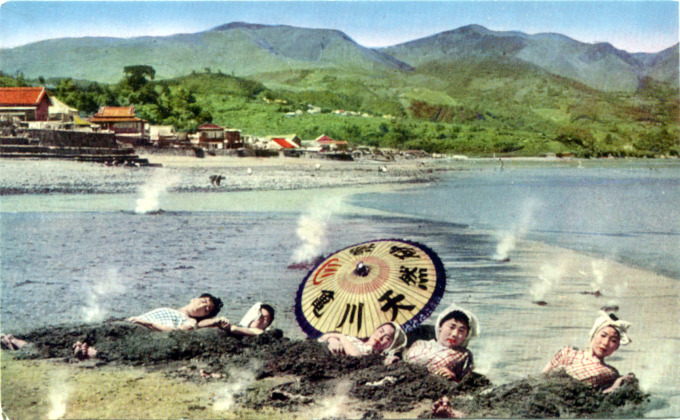
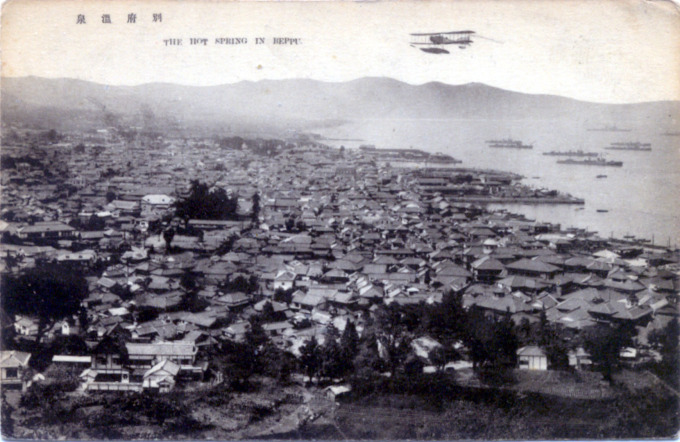
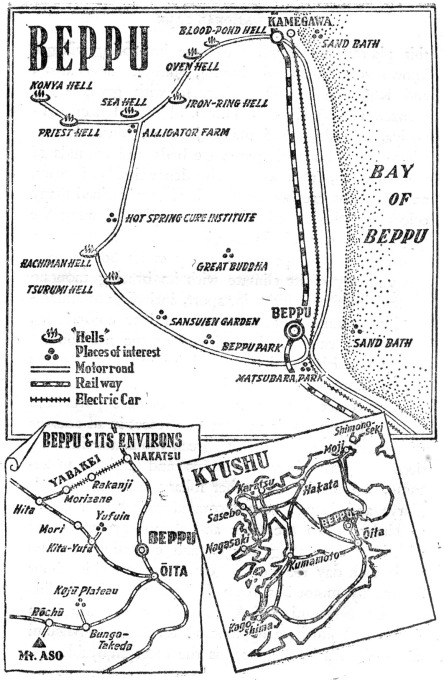
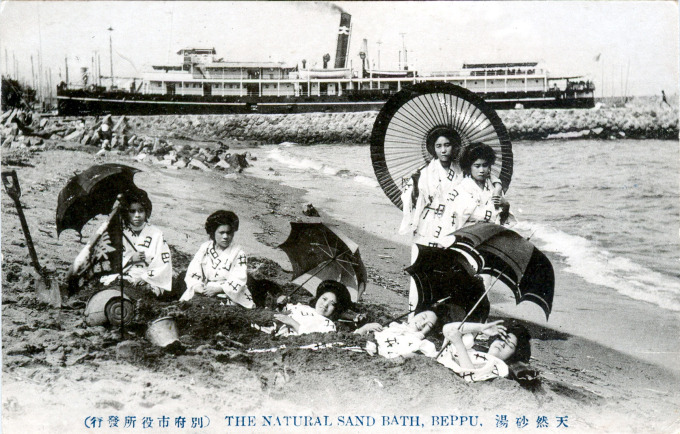
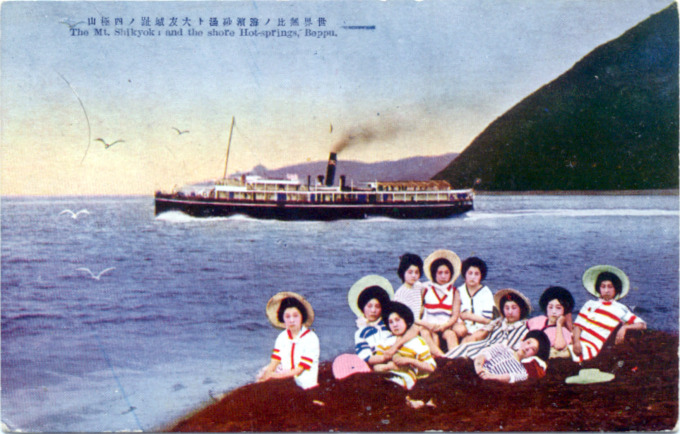
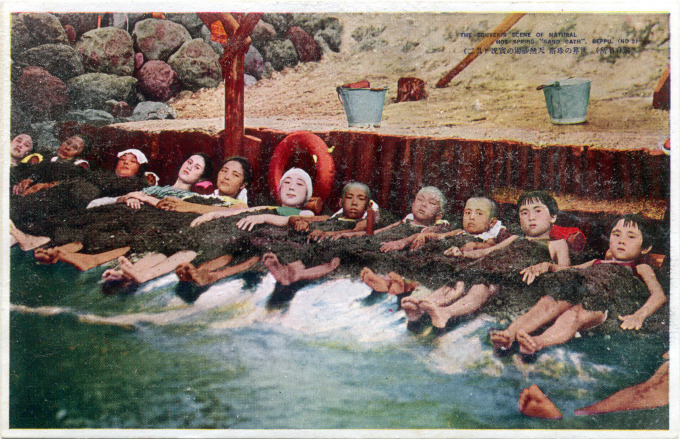
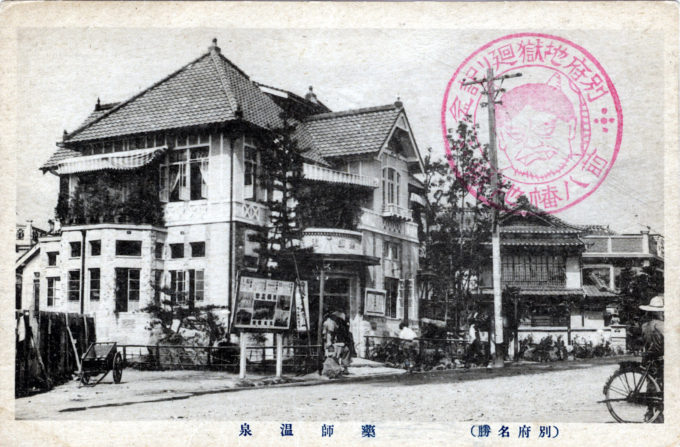
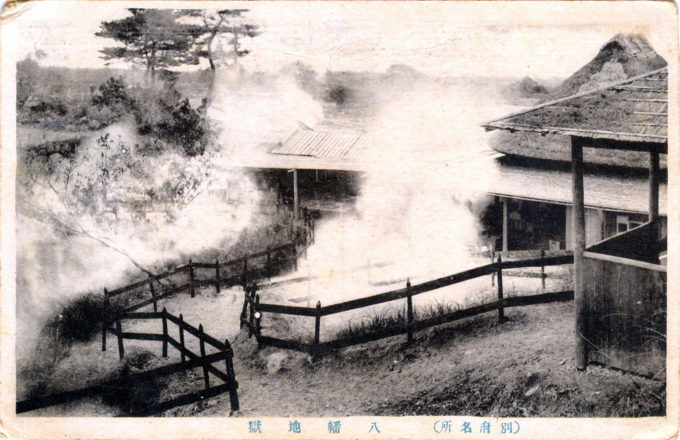
Pingback: Onsen culture. | Old Tokyo
Pingback: Iwaya-Furo, Kawaji Spa, c. 1920. | Old Tokyo
Pingback: Kinosaki Hot Spring, c. 1930. | Old Tokyo
Pingback: Ofuro (bath) culture, c. 1910. | Old Tokyo